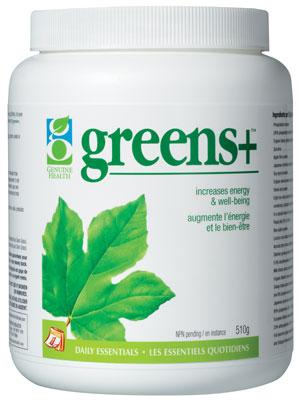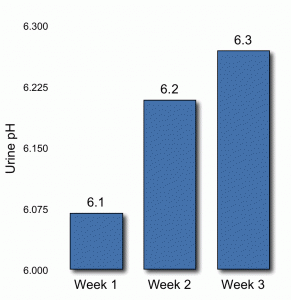Acid/base – why do we care?
A couple of years ago, JB wrote an eye-opening article about how our diets can strongly affect the acid-base balance of our bodies.
Essentially, every single food we eat, from eggs to eggplant, can either present the body with an acid load or an alkaline load. Specifically, most proteins and grains (foods that are pretty abundant in the modern diet) lead to an acid load on the body. And most fruits and veggies (foods that are relatively scarce in the modern diet) lead to an alkaline load on the body.
Well… so what? So this: the acid/base status of our bodies needs to be tightly regulated or else things can go haywire – you know, like, we die and stuff. And in today’s modern dietary climate, this tight regulation is constantly challenged by our diets, which are typically high in acid.
Now, we do have buffering mechanisms in our body: chemical systems that quickly neutralize these dietary acids, preserving our body’s pH (another word for acid/base balance). However, when we eat a high acid diet over long periods of time, our cells suffer.
Here are some of the consequences of a high acid diet:
- Reduced thyroid hormone concentrations
- Increased stress hormones (cortisol and catecholamines)
- Decreased anabolic hormones (growth hormone and IGF)
- Loss of muscle and bone
Needless to say – not good. And getting worse. As we, societally, eat more proteins and grains and fewer fruits and veggies, we continue to introduce more and more acids into the body. The net result: more muscle loss, more fat gain, more osteoporosis, and more disease.
The solution
Again, as JB pointed out in his article, the simple solution to our pH problems is to eat more fruits and veggies – about 8-10 servings per day for recreational exercisers and 12-15 servings for athletes.
However, as the research has noted, only about 95% of the population doesn’t even get 3 servings per day. Ask folks to go from 2 to 10 servings? Uh, that’s a stretch.
For this reason, some nutritional supplement companies have created a category called “green food supplements”. Much like protein powders, green food supplements are powdered fruits and veggies that you can mix with water, milk, juice, whatever. The idea behind them is that they just might help make up for that big lack of fruits and veggies in our diets.
By offering vitamins, minerals, phytonutrients, antioxidants, and a nice acid/base balancing alkaline load, these supplements are marketed as magical health potions that can improve the way you look, the way you feel, and the way you perform.
At least that’s what they say in the ads.
Precision Nutrition’s Informal Experiments team vs. greens+
Probably the one supplement that single-handedly kicked off the green food craze was a product developed by a guy by the name of Sam Graci, called greens+. This product was designed with a host of veggies, herbs, and other supposedly healthy ingredients and claims to have the antioxidant power of 6-10 organic salads.

Since greens+ remains the best selling green food product on the market today, we figured where better to start than the top? We decided to put greens+ to the test. Specifically, we wanted to know if this “super food” product could deliver on at least one of its claims, perhaps the most important one.
In other words, does greens+ actually improve the body’s acid/base balance?
Previous research on the product has demonstrated that:
- greens+ has a strong PRAL score (a measure of alkalinity outside of the body)
- greens+ has a strong ORAC score (a measure of its antioxidant ability outside of the body)
- greens+ can help improve bone growth in tissue cultures (again, in Petri dishes outside of the body)
That’s all good and fine… but all of this research was done in a lab, outside of the human body. And although it’s a good start, one really wants to know what happens when you take the stuff. Good thing there were a few human studies. In this human research, it was demonstrated that
- greens+ can improve overall mood and vitality
- greens+ can help prevent oxidative (free radical) damage in the body
Cool stuff. However, one label claim remained untested. No one bothered to test whether or not greens+ could actually improve acid/base status in the body… until now.
The greens+ experiment
In our Informal Experiment, we invited 34 people (17 men and 17 women not previously taking any greens product and not on any prescription meds) to participate in our little greens+ party.
The men, on average, were 31 years of age and weighed 190lbs. The women, on average, were 36 years of age and weighed 155lbs. After consenting to participate, these individuals were sent the following:
- Full instructions
- A data recording form (in Microsoft Excel format)
- A container of urine test strips (to measure pH)
- A container of unlabelled berry flavoured greens+
For the first week of the Informal Experiment, participants were instructed to measure their urinary pH by collecting their first morning urine in a small glass container and dipping in a pH test strip.
pH test strips turn a specific shade based on the pH of the urine. So, after measuring their urinary pH, participants recorded their morning pH. They repeated this procedure for 7 days. During this time they DID NOT take greens+. They simply measured their urinary pH without taking the supplement.
Next, after the 7 days were up, participants started taking the greens product, one serving in the morning and one in the evening. They continued their urinary pH testing as described above for a total of 14 days.
During this time, they were instructed not to change their diet or their training program. Further, they were instructed not to begin any new supplements or medications. Finally, because they received an unlabelled bottle of greens+, they were blinded to the type of greens supplement they were ingesting (in other words, they didn’t know what was in it).
The greens+ results
We’ve reached the moment of truth. If greens+ actually improves urinary acid/base balance, our Informal Experiment participants would see increases in their urinary pH. You see, lower pH values mean that the urine is more acidic. And higher values mean that the urine is more basic.
However, if greens+ doesn’t deliver as promised, we’d either see no change in urinary pH or we’d see a lowering in urinary pH. So, what did we find?
| Average pH for Week 1 (Without greens+) |
Average pH for Week 2 (With greens+) |
Average pH for Week 3 (With greens+) |
|---|---|---|
| 6.07 +/- 0.04 | 6.21 +/- 0.03* | 6.27 +/- 0.06* |
Interestingly, in this Informal Experiment, participants, on average, began with pH values below optimal, but with the addition of greens+ ended up being in the optimal range (6.2 – 7.0 is optimal). Good news.
*Note: For you statisticians, the changes between week 1 and weeks 2 and 3 were statistically significant at the p<0.01 level. For you non-statisticians, this means that when subjected to statistical scrutiny, greens+ definitely changed urinary pH in a positive way.
When the participants were examined individually, we noticed the following:
- 62% of the participants saw an increased (more basic) urinary pH – this is good
- 29% of the participants saw a decreased (more acidic) urinary pH – this is not so good
- 9% of the participants saw no change in urinary pH – this is neutral
So, what happened to the people who either saw no change or a negative change? Well, interestingly, initial pH values explain this difference.
You see, those folks who saw no change or negative changes actually started out with higher (more basic) urinary pH values (6.29). And those folks who saw the positive changes actually started out with lower (more acidic) urinary pH values (5.49). So it looks like greens works better for those with more acidic urine than for those who are starting out more alkaline.
Wrap up
So there you have it. We put greens+ to the test and found that yes indeed, it does stand up to another of its label claims. Here’s what we found:
- In the group as a whole, urinary pH was below optimal before supplementation. On average, the group was just too acidic.
- In the group as a whole, greens+ supplements increased urinary pH, increasing alkalinity in the urine and presumably improving the acid/base status of the body.
- In general, supplementation with greens+ brought these participants into the optimal pH range.
- As with most interventions, not everyone saw the same types of improvements. This may be due to different starting pH values. Those with a higher starting pH seem to have less benefit than those with a lower starting pH.
Bottom line, if you currently eat a diet that’s high in proteins and/or grains and a diet that’s low in fruits and veggies, chances are you’re too acidic. In that case, you’d be a perfect candidate for supplementing with a product like greens+.
Informal Experiments gets legit!
So what did we do with all this great data besides get it to you, the PN readers? Why, submit it to a scholarly journal, of course! Hot off the presses, here’s the academic version:
Berardi, John M, Alan C Logan and A Venket Rao. Plant-based dietary supplement increases urinary pH. Journal of the International Society of Sports Nutrition 2008, 5:20doi:10.1186/1550-2783-5-20 [Link to full text of study]
Abstract: Research has demonstrated that the net acid load of the typical Western diet has the potential to influence many aspects of human health, including osteoporosis risk/progression; obesity; cardiovascular disease risk/progression; and overall well-being. As urinary pH provides a reliable surrogate measure for dietary acid load, this study examined whether a plant-based dietary supplement, one marketed to increase alkalinity, impacts urinary pH as advertised. Methods: Using pH test strips, the urinary pH of 34 healthy men and women (33.9+/-1.57 y, 79.3 +/-3.1 kg) was measured for seven days to establish a baseline pH without supplementation. After this initial baseline period, urinary pH was measured for an additional 14 days while participants ingested the plant-based nutritional supplement. At the end of the investigation, pH values at baseline and during the treatment period were compared to determine the efficacy of the supplement. Results: Mean urinary pH statistically increased (p=0.03) with the plant-based dietary supplement. Mean urinary pH was 6.07 +/- 0.04 during the baseline period and increased to 6.21 +/- 0.03 during the first week of treatment and to 6.27+/-0.06 during the second week of treatment. Conclusions: Supplementation with a plant-based dietary product for at least seven days increases urinary pH, potentially increasing the alkalinity of the body.
Ok, that’s it for this edition of Precision Nutrition Informal Experiments. Stay tuned for more great experiments coming up. And if you want to participate in of these upcoming projects, keep an eye out for our recruiting announcements.
Learn more
Want to get in the best shape of your life, and stay that way for good? Check out the following 5-day body transformation courses.
The best part? They're totally free.
To check out the free courses, just click one of the links below.





Share